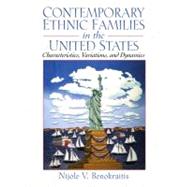
Note: Supplemental materials are not guaranteed with Rental or Used book purchases.
Purchase Benefits
What is included with this book?
Nijole V. Benokraitis received her Ph.D. is sociology from the University of Texas, Austin. She is currently Professor of Sociology at the University of Baltimore. Dr. Benokraitis has authored, coauthored, edited, or coedited Feuds about Families: Conservative, Centrist, Liberal, and Feminist Perspectives; Subtle Sexism: Current Practices and Prospects for Change; Marriages and Families: Changes, Choices and Constraints (3d ed.); Modern Sexism: Blatant, Subtle, and Covert Discrimination (2d ed.); Seeing Ourselves: Classic, Contemporary and Cross-Cultural Readings in Sociology (5th ed.); and Affirmative Action and Equal Opportunity: Action, Inaction, and Reaction. She is a member of the editorial board of Women and Criminal Justice, reviews manuscripts for several periodicals, and has published numerous journal articles in the areas of institutional racism, discrimination in government and higher education, and social policy. She has for some time served as a consultant in the areas of sex and race discrimination to women's commissions, business groups, colleges and universities, and state and federal government programs.
| Preface | vii | ||||
| Contributors | xii | ||||
| About the Editor | xv | ||||
|
1 | (14) | |||
|
|||||
|
15 | (40) | |||
|
18 | (11) | |||
|
|||||
|
|||||
|
29 | (7) | |||
|
|||||
|
36 | (7) | |||
|
|||||
|
43 | (6) | |||
|
|||||
|
49 | (6) | |||
|
|||||
|
55 | (38) | |||
|
58 | (8) | |||
|
|||||
|
66 | (5) | |||
|
|||||
|
71 | (7) | |||
|
|||||
|
|||||
|
78 | (5) | |||
|
|||||
|
83 | (10) | |||
|
|||||
|
93 | (34) | |||
|
96 | (5) | |||
|
|||||
|
|||||
|
101 | (4) | |||
|
|||||
|
105 | (5) | |||
|
|||||
|
|||||
|
|||||
|
|||||
|
|||||
|
110 | (10) | |||
|
|||||
|
120 | (7) | |||
|
|||||
|
127 | (44) | |||
|
130 | (11) | |||
|
|||||
|
|||||
|
141 | (8) | |||
|
|||||
|
149 | (7) | |||
|
|||||
|
156 | (6) | |||
|
|||||
|
162 | (9) | |||
|
|||||
|
|||||
|
171 | (46) | |||
|
174 | (15) | |||
|
|||||
|
|||||
|
|||||
|
189 | (10) | |||
|
|||||
|
199 | (6) | |||
|
|||||
|
205 | (7) | |||
|
|||||
|
212 | (5) | |||
|
|||||
|
217 | (42) | |||
|
220 | (6) | |||
|
|||||
|
226 | (6) | |||
|
|||||
|
232 | (8) | |||
|
|||||
|
240 | (11) | |||
|
|||||
|
251 | (8) | |||
|
|||||
|
259 | (48) | |||
|
263 | (6) | |||
|
|||||
|
|||||
|
|||||
|
269 | (10) | |||
|
|||||
|
279 | (10) | |||
|
|||||
|
289 | (10) | |||
|
|||||
|
|||||
|
|||||
|
299 | (8) | |||
|
|||||
|
307 | (44) | |||
|
310 | (8) | |||
|
|||||
|
|||||
|
|||||
|
|||||
|
|||||
|
|||||
|
|||||
|
318 | (4) | |||
|
|||||
|
322 | (9) | |||
|
|||||
|
|||||
|
331 | (10) | |||
|
|||||
|
341 | (10) | |||
|
|||||
|
351 | (44) | |||
|
354 | (6) | |||
|
|||||
|
360 | (8) | |||
|
|||||
|
368 | (10) | |||
|
|||||
|
|||||
|
378 | (7) | |||
|
|||||
|
|||||
|
385 | (10) | |||
|
|||||
| Internet Resources | 395 | (5) | |||
| Photo Credits | 400 |
The New copy of this book will include any supplemental materials advertised. Please check the title of the book to determine if it should include any access cards, study guides, lab manuals, CDs, etc.
The Used, Rental and eBook copies of this book are not guaranteed to include any supplemental materials. Typically, only the book itself is included. This is true even if the title states it includes any access cards, study guides, lab manuals, CDs, etc.